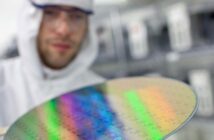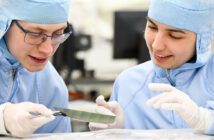Brightlands Chemelot continues robust growth
The Brightlands Chemelot Campus in Sittard-Geleen is home to various research institutes where researchers, engineers and students develop and test new biobased and other materials. The 3D printing centre, the Chemelot Institute for Science and Technology (InSciTe) and the Brightlands Materials Center (BMC) together develop ideas into concrete products, linking up science with the business community. LINK paid them a visit.
Brightlands Materials Center: new materials and applications
“A little lab”, is how managing director Marnix van Gurp of BMC describes the laboratory which opened last February on the campus in Sittard-Geleen, literally in the shadow of chemicals giants DSM, SABIC, ARLANXEO, Sekisui and several other global players. “We are starting small and gradually expanding our activities. At the moment, there are a little over 20 researchers working here. By the end of the year, that number will have doubled and we will also have more equipment. For example, an extruder will soon be delivered that we can use to produce new materials and composites on a small scale. That’s important in order to test materials in practice.”
TNO
The ‘little’ in-house lab was already envisaged when TNO, the Netherlands Organisation for Applied Scientific Research, and the province of Limburg decided to invest €45 million in BMC in early 2015, but its construction is being brought forward. “We already had the opportunity to use TNO’s facilities in Eindhoven and the spacious labs here at Brightlands. Great, so why invest millions in equipment which already exists and is available for us to use? Well, some types of research are best done in a more isolated environment, partly for competitive reasons. On top of that, TNO said it wanted its own site in Geleen. Hence we are moving into our own space at Brightlands Geleen earlier than planned.”
So BMC is developing faster than expected? “Correct”, continues Marnix van Gurp. “Some of our partners have been with us from day one, including large companies such as SABIC and DSM, smaller innovative firms such as Kriya and other research institutes. And of course universities, including those of Eindhoven and Maastricht. BMC has solid foundations. We are now slowly moving towards more concrete results which are also of interest to the outside world. A good example is a project under OP-Zuid (the operational programme for the South of the Netherlands), involving a study into thermoplastics in which 11 firms are involved.”
Materials
What exactly does the Brightlands Materials Center do? “We are totally focused on research into new, sustainable technologies in the area of plastics and their applications. These can be traditional polymers based on crude oil, but they can just as easily be made from plant-based raw materials. On the one hand, it is about translating scientific knowledge into concrete materials and applications; on the other hand, we are working on behalf of entrepreneurs with innovative ideas. The start-ups and smaller firms in particular don’t have the resources to equip their own labs or hire in scientific expertise. We help them turn those great ideas into concrete products and applications.”
Brightlands Materials Center is developing faster than expected, says managing director Marnix van Gurp.
BMC broadly differentiates three programmes: “Lightweight materials for the automotive sector, materials suitable for 3D printing, and plastics for electrical and optical applications. For example, we are researching which light-weight materials are suitable for cars. We do this in a proactive way, obviously with the aim of interesting car manufacturers and suppliers. The same goes for coatings and films. We are currently researching how a coating with nano particles can make a solar cell more effective. We employ engineers and researchers who, together with PhD students, research and test everything right down to the molecular level. Our partners have access to the results and are therefore able to use them to start businesses or to develop their teaching programmes.”
Companies
The BMC site at Brightlands in Geleen is of particular interest to young chemicals firms. Marnix van Gurp: “All the facilities are present on this campus. Companies moving here have the right permits straight away, the infrastructure is there – research institutes, pilot plants, plus things like security and contacts with financiers. Our partners get access to knowledge, talent and support. We call that shared research. They decide for themselves how much know-how they want to put in. Competitors can work side-by-side in a safe environment here.”
Over the coming years, BMC wants to further expand its number of programmes. One of the areas they focus on is sustainability. “We are expecting a lot from the circular economy and we are looking for new applications for recycled plastics. So we’re going to grow, but we don’t want to have to keep on reinventing the wheel. We are working together closely with the Chemelot Innovation and Learning Labs (CHILL) here on the site. Where possible, we share the operational management and costs and reinforce one another.”
InSciTe already looking to expand
Last summer, InSciTe, the Institute for Science and Technology, opened its new biomedical laboratory at the Chemelot Brightlands Campus. “The new biomedical facility makes InSciTe unique far and wide”, says managing director Emiel Staring. “We now have a certified GMP lab for developing biomedical materials. We don’t just conduct research into new materials and applications here; the labs are also available for other parties to use. There is a lot of interest in hiring our laboratory space and clean rooms. For example, from entrepreneurs who want to test the effectiveness and feasibility of their ideas and inventions.. In most cases, they don’t have the resources to invest in equipment or advanced conditions, such as a clean room. Performing tests also requires certain skills. Here, everything is done by the book by specialised and experienced employees. Which is relevant when it comes to getting a medical application certified, for example. In combination with the other facilities and research centres here at Brightlands, that makes us attractive to both established firms and start-ups working on new materials for biomedical and industrial applications.”
Projects
In 2014, Maastricht University and University Medical Center, Eindhoven University of Technology, DSM, Brightlands Chemelot Campus and the province of Limburg provided the required €80 million to set up InSciTe. The first projects were kicked off early last year, together with businesses and research institutes. “It’s going quicker than we expected. We currently have eight different projects in our portfolio”, continues Emiel Staring. “Three projects are working on new raw materials based on wood and agricultural waste. Five projects are concerned with growing bone for implants and the regeneration of blood vessels, among other things.”
 Partnership
Partnership
InSciTe has three areas of focus. The institute for the exploitation of research results initiates research projects, involving scientists from various universities, including Maastricht University and the Eindhoven University of Technology. InSciTe also hires out its expertise and facilities to businesses. “We can offer flexible services or provide a complete package. We also draw strength from our partnerships with the other institutes, research bodies and companies on the Brightlands campuses here in Geleen and in Maastricht. The pilot plants on the site will soon be ready, which means we will be able to scale up the processes for bio-based materials. Based on that, entrepreneurs can decide to scale up further in their own factories. We also have connections with subsidy providers and investors, IP experts and marketeers. We are training a new generation of enterprising researchers who are translating science into applications for society. The aim is very much to generate business.”
International
Slowly but surely, InSciTe is gaining a name for itself. “Internationally, too”, notes Emiel Staring. “Talks are ongoing with companies and institutes from Belgium, Germany, the UK and Denmark. We are already looking into options for expanding the labs. Our ambition is to play a pioneering role in new materials, biomedical and manufacturing. We are well on the way.”
3D printing centre comes of age
In 2014, work started on building a 3D printing ecosystem at the Brightlands Chemelot Campus. Having started modestly with several relatively simple printers, there is now a battery of 19 printers, suitable for seven technologies. “Ranging from a little printer for plastics to printers for biomedical applications and all kinds of metals and plastics”, says Ed Rousseau, business development manager. “Fortunately, at the end of this year, we will be moving to the former DSM machine shop, which means we will gain some extra space. At that point, we will also be able to install advanced printers, including those belonging to TNO; some of these devices are worth in excess of €1 million.”
A broad range
“We therefore offer a broad range of options. We offer entrepreneurs and researchers the opportunity to test materials and applications using equipment which would otherwise be unaffordable, certainly for small parties or start-ups. And we have the expertise in-house to use that equipment. In this way, we are boosting entrepreneurship and innovation. The 3D printing ecosystem also plays a central role in the inventions of the BMC, AIMBM and InSciTe research institutes. They research whether new materials are suitable for printing.”
Xilloc
An important partner is Xilloc, which specialises in implants and is based at the BMC, where it has brand-new printers. “An important partner, which also attracts other businesses in the biomedical sector. But there is more. For example, a satellite manufacturer prints certain of its components here. We are currently working in partnership with 64 firms and institutes. We will continue to grow over the coming years. 3D printing is perfect for manufacturing complex and light components for the aerospace industry, for making complicated spare parts and for custom-made hearing aids, dental implants, and so on.”
Some €13.5 million have been invested in the 3D printing ecosystem at Brightlands Chemelot Campus; it now employs nearly 40 people and 17 scientists are working on their doctorates there.
Brightlands has four campuses:
- Brightlands Chemelot Campus, focused on high-end materials.
- Brightlands Maastricht Health Campus, focused on health.
- Brightlands Campus Greenport Venlo, focused on health and nutrition.
. Brightlands Smart Services Campus, focused on smart services and data science.
What they have in common is mutual cooperation across diverse scientific disciplines, geographical areas and organisations, such as start-ups and multinationals, but also the academic world and business community.






